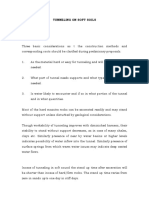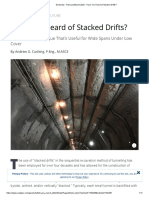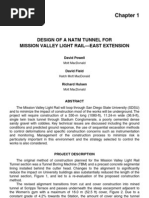2013 Behavior of Surrounding Soil During Construction Using Pipe Jacking in Deep Strata
2013 Behavior of Surrounding Soil During Construction Using Pipe Jacking in Deep Strata
Uploaded by
pasak.phase2Copyright:
Available Formats
2013 Behavior of Surrounding Soil During Construction Using Pipe Jacking in Deep Strata
2013 Behavior of Surrounding Soil During Construction Using Pipe Jacking in Deep Strata
Uploaded by
pasak.phase2Original Title
Copyright
Available Formats
Share this document
Did you find this document useful?
Is this content inappropriate?
Copyright:
Available Formats
2013 Behavior of Surrounding Soil During Construction Using Pipe Jacking in Deep Strata
2013 Behavior of Surrounding Soil During Construction Using Pipe Jacking in Deep Strata
Uploaded by
pasak.phase2Copyright:
Available Formats
Open Journal of Geology, 2013, 3, 44-48
http://dx.doi.org/10.4236/ojg.2013.32007 Published Online April 2013 (http://www.scirp.org/journal/ojg)
Behavior of Surrounding Soil during Construction and Its
Countermeasures Using Pipe Jacking Method in Deep
Strata
Takashi Senda, Hideki Shimada, Takashi Sasaoka, Kikuo Matsui
Department of Earth Resources Engineering, Kyushu University, Fukuoka, Japan
Email: m-sen@obayashi-road.co.jp
Received February 4, 2013; revised March 8, 2013; accepted April 8, 2013
Copyright © 2013 Takashi Senda et al. This is an open access article distributed under the Creative Commons Attribution License,
which permits unrestricted use, distribution, and reproduction in any medium, provided the original work is properly cited.
ABSTRACT
In Japan when urban infrastructures need to be constructed, the difficulty of utilizing the ground or shallow strata will
lead to a more frequent use of the deep strata. The common construction methods are open-cut, pipe jacking, and shield
methods. In recent years, a new pipe jacking method has been established that can be adapted to 20 m below the ground
or more. Using this method, the drivage machine and the jacking pipe continue to move an underground until the com-
pletion of the driving. Therefore an over-cutting area (so-called tail-void) must be formed to lower the friction between
the ground and the pipe. The tail-void is filled with lubrications. However, because the stress release from the ground
continues to advance when the tail-void is formed, hence there are some challenges required to cope with the stability of
the surrounding ground. In order to utilize the pipe jacking method in the deeper strata layers, the theory, analysis and
installation of tail-void have to be systemized, and such systematic data must be stored. Therefore, the conditions of
tail-void in the deep pipe jacking method are discussed using numerical analyses.
Keywords: Pipe Jacking System; Deep Strata; Tail-Void
1. Introduction Generally used construction methods include open-cut,
pipe jacking, and shield methods. In the past, even during
In Japan, the land of large metropolitan areas is highly
construction of the shallow strata, open-cut methods
utilized in increasingly complex conditions; therefore, the were widely used because construction had to be precise,
underground area is used to establish social infrastruc- reliable, and economically efficient. However, due to the
tures because of difficulties to use on the ground. Even in neighboring construction it is difficult to secure road
the publicly used shallow strata such as road sections, so- traffic, prevent construction hazards such as vibration and
cial infrastructures including subways, water and sewage noise, and to also take steps to protect the existing con-
systems, electrical equipment, communications facilities, gested underground installations. On the other hand, the
and gas pipelines have already been installed and are very pipe jacking method has been widely adopted as a gen-
congested. Nowadays, when urban infrastructures need to eral construction method owing to its recent marvelous
be further constructed, the difficulty of using the ground or technological development [1].
shallow strata will lead to the more frequent use of the Nowadays, in order to grasp the ground constructions
deep strata. after using the shield method, the movement of the ground
The general advantages of using the deep strata which is frequently predicted by numerical analysis. Many cases
will help maintain the quality of social capital include are recognized as plain strain and axisymmetric problems
stability, earthquake resistance, constant temperature and in the sectional and vertical directions in the shield con-
humidity, and blockages of vibration and noise, all of struction. In this paper, various factors that may influ-
which will not affect the view on the ground. A good ence the deformation of the surrounding ground are si-
quality of social infrastructure can be installed by taking mulated and analyzed. These factors include the balanc-
advantages of the deep strata construction. Consequently, ing between the pressure of cutting face and the earth
the development of an effectively, appropriately designed pressure, the cutting condition of the face, ground defor-
deep strata will be strongly encouraged. mation by excavation, the friction between the surround-
Copyright © 2013 SciRes. OJG
T. SENDA ET AL. 45
ing surface of drivage machine and its contact ground, vage machine.
generation of tail-void, and lubricant. Those analysis 3) By repetition of the pushing process, if the rear-end
were considered using the finite element method, which driving after one concrete pipe length (2.5 m) is driving
produce great results for the prediction of deformation in, connect another pipe.
behavior of the ground during the shield construction. 4) After driving is completed, recover the drivage ma-
From this point of view, this method was adopted for chine from the arrival pit.
analyzing the pipe jacking method [2]. More widely used techniques that are now being used
elsewhere for micro-tunneling, use remote control dri-
2. What is the Pipe Jacking vage methods in conjunction with pipe jacking. During
In the pipe jacking method, drivage machine is set at the the pushing processes, the mud slurry is injected into the
head of the pipeline and the pipes are jacked forward face and tail-void, which is between the pipe and the soil.
with the hydraulic jack, located at the starting shaft. After tail-void is filled by the slurry, soil is stabilized due
The pipe jacking, like many other methods of below to the slurry pressure. To minimize ground deformation
ground construction, is best employed in stable, water in the pushing process, it is necessary to maintain the
free soil conditions. Unfortunately, with the demands on slurry pressure that was kept on the underground water
available space and the need to provide more services, it pressure at plus 20 kPa [5].
is not always possible to select stable strata, which means Thus, tail-void plays an important role in reducing the
that contractors have to contend with difficult ground be- friction resistance in pushing the pipes and maintaining
low the water table [3,4]. The slurry pipe jacking system earth covering pressure.
is applicable to the above situations.
Figure 1 shows the pipe jacking system scheme. This 3. Numerical Analysis
system can be used to construct pipe tunnels up to 3000 The boundary conditions of the ground, where the pipe
mm in diameter and construct both long (maximum length: jacking construction is made, are so complex and wide-
1000 m) and curved tunnels (minimum curvature radius: ranging that in many cases 3-dimentional effect cannot
25 m). be ignored when considering the design of the pipe jack-
Recent technological developments have led to suc- ing construction. Therefore, excavation elements were
cessful methods for stabilizing unstable strata by exclud- used to create a 3-dimentional finite element method con-
ing water from excavations by means of tail-void with sidering the actual construction process of pipe jacking
mud slurry. This system meets modern environmental construction.
standards. This type of mud slurry is formed by water, de-
composed granite soil, carboxyl methyl cellulose, lost 3.1. Outline of Analysis
circulation control material, bentonite, fine aggregate,
and other materials. Figure 2 shows an illustration of the In the pipe jacking construction, just after the drivage
pipe and the soil in this system. The proportional mixes machine passes by the tail, the tail-void is generated due
vary the viscosity and the seepage capacity of the mud to the difference of the outer diameter of each pipe,
slurry and will be determined by whether mud slurry is which releases stress in the ground. As the actual con-
required to strengthen the soil. struction lubricant is injected into the tail-void to prevent
This system is used as follows: the ground from deformation due to stress release caused
1) Install the pushing equipment in the starting pit, and by formation of the tail-void in the ground. To simulate
then set the drivage machine. this situation in the analysis, a nodal force equivalent to
2) Extend the rear-end pushing jack and push the dri- the injection pressure is applied to the soil element where
Figure 1. Pipe jacking scheme.
Copyright © 2013 SciRes. OJG
46 T. SENDA ET AL.
the stress is released after the tail of the drivage machine
passes by.
3.2. Input Parameters
Tables 1 and 2 show the input parameters used in the
analysis. The appropriate pressure of the cutting face must
be applied against the earth covering.
The material values of the lubricant were the ones that
are illustrated graphically with the logarithmic functional
approximation value of Young’s modulus and Poisson’s
ratio according to the result of the uniaxial compression
test as shown in Figure 3.
Figure 4 shows analysis model. A half section model
with a length of 40 m and a width of 150 m was used as
the analysis range because both loading and structural sys-
tems were symmetrical.
4. Results and Discussion Figure 3. Young’s modulus and Poisson’s ratio elapsed time
after injection.
Figure 5 shows the deformations of the crown at the tail-
void during pipe jacking of 10, 20 and 30 m. The pres-
sure of the cutting face was acted against the front face of
Figure 4. Analysis model.
excavation, causing upheaval before settlement starts. Af-
ter the drivage machine passes by, settlement is generated
Figure 2. Illustration of a concrete pipe and soil. from 30 to 35 mm. Constructing tail-void cause large de-
formation. Therefore, this phenomenon should be taken
Table 1. Properties of soils, pipe and lubricant. care in pipe jacking.
Lubricant Figure 6 shows the deformations of the crown at the
Mud-stone Clay Sand Pipe tail-void when pipe jacking has reached a 30 m point of
After 1 month
injection passed excavation at the various earth coverings of 20, 40, and
60 m. As the earth covering increases, the deformation
Young’s amount of tail-void also increases. At the earth covering
modulus: E 74 50 55 2.2 × 103 9.8 × 10−4 0.43
(MPa) of 40 m, settlement has reached a maximum of about 34
mm.
Poisson’s
ratio: ν
0.30 0.33 0.35 0.20 0.45 0.39 Figure 7 shows the deformation amount dependency
to the soil properties. A tendency was found that the lar-
Density
0.021 0.024 0.021 0.080 0.021 0.021 ger the cohesion is, the smaller the deformation amount.
(MN/m3)
In particular, the deformation amount of sandy soil and
Table 2. Cutting face pressure. cohesive soil reached 50 mm or more, which is generally
a value that cannot secure an effective area of tail-void.
Earth covering: H Cutting face pressure (MPa) The analytical results this time show that even under
20 m 0.44
the conditions of easy-to-collapse soil and high water pres-
sure, if mud screen is able to retain the area of surround-
40 m 0.86
ing pipes with enough pressure to cope with the earth
60 m 1.28 pressure and hydraulic pressure, then it can decrease fric-
Copyright © 2013 SciRes. OJG
T. SENDA ET AL. 47
tional forces on pipelines. This is very effective in con-
struction.
Based on the analytical results shown in Figure 5,
Figure 8 shows that the range, affected by the amount of
surface settlement of the ground surface and the top layer
at the center of drivage machine, became smaller, if the
earth covering became larger. It was 3.4 mm at an earth
covering of 60 m. It is presumed that the range affected
by the ground subsidence in the horizontal direction should
be on a straight line of about 42 degree.
5. Conclusion
Based on the analytical results, it was found that if the
Figure 8. Relationship between the vertical displacement on
earth covering in the deeper ground increases, the sur- the surface and the distance from the center.
rounding soil during the pipe jacking construction, and
the tail-void in particular, must be looked at, due to the
increased deformation.
Now that long distance and narrow curve jacking tech-
niques have been established and watertight joints for
installation have been rapidly developed, the pipe jacking
method can be applied to the pipe installation in under-
ground deeper than 20 m of earth covering. However, the
stress release of the ground continues along with the for-
mation of tail-void. Therefore, there are many challenges
to cope with for the improvement of stability in the sur-
rounding ground.
Figure 5. Effect on the deformation by differences of thrust While the drivage machine approaches and passes by,
length: L (m). the stress and strain conditions change with time. Plural
factors, such as changing position of drivage machine
and surrounding friction, can often affect the ground si-
multaneously. In addition, a long-term ground subsi-
dence followed by the ground deformation at the time of
construction can be caused directly by the soil distur-
bance resulting from the ground deformation during con-
struction. Therefore most of the ground deformations caused
by the pipe jacking construction may be caused by chang-
ing stress and strain conditions over the course of con-
struction.
That is why the discussion of appropriate lubricants
Figure 6. Effect on the deformation by differences of earth and injection methods, etc. in preparation for such chang-
covering: H (m). es is inevitable.
REFERENCES
[1] Japan Tunneling Association, “Trend of Using Deep Un-
derground and Activity Report,” 1997.
[2] H. Akagi and K. Komiya, “Ground Behavioral Analysis
in Consideration of the Construction Process of Shield
Tunneling in Finite Element Method,” Journal of Japan
Society of Civil Engineers, Vol. III-25, No. 481, 1993, pp.
59- 68.
[3] J. M. Cole, “Pipe Jacking Case Histories, Tunnels and Tun-
neling,” 1977.
Figure 7. Effect on the deformation by differences of soils. [4] C. M. Hough, “Pipe Jacking Case Histories, Tunnels and
Copyright © 2013 SciRes. OJG
48 T. SENDA ET AL.
Tunneling,” 1978. gress on Tunneling and Ground Conditions, Cairo, April
[5] S. Katano and T. Ogawa, “Effect of Slurry Shield Tun- 1994, pp. 151-156.
neling in Soft Alluvial Clay on an Adjacent Underground
Subway Structure,” Proceedings of International Con-
Copyright © 2013 SciRes. OJG
You might also like
- Advanced Higher Mechanics Formula List COMPLETENo ratings yetAdvanced Higher Mechanics Formula List COMPLETE8 pages
- Calculation of The Thurst Force For Pipeline Installation Using DPINo ratings yetCalculation of The Thurst Force For Pipeline Installation Using DPI11 pages
- Studies On Soil Disturbance Caused by Grouting in Treating Marine Clay100% (1)Studies On Soil Disturbance Caused by Grouting in Treating Marine Clay9 pages
- Aircraft Design Project - Ii Design of Bomber Aircraft A Project ReportNo ratings yetAircraft Design Project - Ii Design of Bomber Aircraft A Project Report73 pages
- (IISc Lecture Notes Series, V. 3) M L Munjal - Noise and Vibration ControlNo ratings yet(IISc Lecture Notes Series, V. 3) M L Munjal - Noise and Vibration Control294 pages
- Trenchless Technology' Techniques and Examples of Successful PracticeNo ratings yetTrenchless Technology' Techniques and Examples of Successful Practice4 pages
- (2006) Monitoring of Over Cutting Area and Lubrication Distribution in A Large Slurry Pipe Jacking OperationNo ratings yet(2006) Monitoring of Over Cutting Area and Lubrication Distribution in A Large Slurry Pipe Jacking Operation21 pages
- The Impact of Pipe Jacking Method Entrance and ExiNo ratings yetThe Impact of Pipe Jacking Method Entrance and Exi7 pages
- Effects of The Chemical Grout Injection On The Surrounding Soil.....No ratings yetEffects of The Chemical Grout Injection On The Surrounding Soil.....11 pages
- Challenging Features in Design and Execution of A Low Overburden Underpass - A Case History From Malaysia: PLUS North-South HighwayNo ratings yetChallenging Features in Design and Execution of A Low Overburden Underpass - A Case History From Malaysia: PLUS North-South Highway10 pages
- Modeling of Pipe Arch Canopies in Shallow Soft Ground Tunnels Constructed by Sequential Excavation MethodsNo ratings yetModeling of Pipe Arch Canopies in Shallow Soft Ground Tunnels Constructed by Sequential Excavation Methods8 pages
- Numerical Study of a Shield Tunnel Driven in Soft Saturated Soil with Respect to Earthquake LoadingNo ratings yetNumerical Study of a Shield Tunnel Driven in Soft Saturated Soil with Respect to Earthquake Loading8 pages
- 2002 Analysis and Prediction of Thrust in Using Slurry Pipe Jacking MethodNo ratings yet2002 Analysis and Prediction of Thrust in Using Slurry Pipe Jacking Method8 pages
- Ground Deformations Above A Large Shallow Tunnel ENo ratings yetGround Deformations Above A Large Shallow Tunnel E10 pages
- Applications of Jet Grouting in Ground Improvement Field.No ratings yetApplications of Jet Grouting in Ground Improvement Field.18 pages
- Ground Movement and Tunnel Stability When TunnelinNo ratings yetGround Movement and Tunnel Stability When Tunnelin13 pages
- Numericalanalysisofinfluenceofdeepexcavationonnearbyexistingtunnel 140824231703 Phpapp01 PDFNo ratings yetNumericalanalysisofinfluenceofdeepexcavationonnearbyexistingtunnel 140824231703 Phpapp01 PDF5 pages
- Design and Construction of The Deepest Diaphragm Walls in CairoNo ratings yetDesign and Construction of The Deepest Diaphragm Walls in Cairo8 pages
- Zhang 2020 IOP Conf. Ser. Mater. Sci. Eng. 782 042009No ratings yetZhang 2020 IOP Conf. Ser. Mater. Sci. Eng. 782 0420096 pages
- Numerical Analysis of Shallow Tunnels in Soft Ground Using Plaxis2dNo ratings yetNumerical Analysis of Shallow Tunnels in Soft Ground Using Plaxis2d6 pages
- Omar Y. Mohammed and Ammar A. Shiekha: Dewatering System Control by MATLAB SoftwareNo ratings yetOmar Y. Mohammed and Ammar A. Shiekha: Dewatering System Control by MATLAB Software9 pages
- Ground Movement and Tunnel Stability When TunnelinNo ratings yetGround Movement and Tunnel Stability When Tunnelin13 pages
- Large Diameter Pipe Roof Box Excavation For Passenger Linkway TunnelNo ratings yetLarge Diameter Pipe Roof Box Excavation For Passenger Linkway Tunnel14 pages
- Geostrata - Have You Heard of Stacked DriftsNo ratings yetGeostrata - Have You Heard of Stacked Drifts11 pages
- Design of A NATM Tunnel For Mission Valley Light Rail - East ExtensionNo ratings yetDesign of A NATM Tunnel For Mission Valley Light Rail - East Extension12 pages
- An Introduction To Pipe Jacking and Microtunelling Design100% (2)An Introduction To Pipe Jacking and Microtunelling Design27 pages
- Ground Movement and Tunnel Stability When TunnelinNo ratings yetGround Movement and Tunnel Stability When Tunnelin13 pages
- Numerical Simulation of A Deep Excavation Near A Shield TunnelNo ratings yetNumerical Simulation of A Deep Excavation Near A Shield Tunnel9 pages
- Geological Difficulties in Tunnelling For Nathpa Jhakri HEPNo ratings yetGeological Difficulties in Tunnelling For Nathpa Jhakri HEP10 pages
- Soft Ground Tunneling For MRT in Urban Areas0% (1)Soft Ground Tunneling For MRT in Urban Areas15 pages
- Final ZawZawAye CutCoverTunnel SEACETUS2017 20feb17 Ohm RNo ratings yetFinal ZawZawAye CutCoverTunnel SEACETUS2017 20feb17 Ohm R9 pages
- CBIP 2007 - Gnagar Workshop - J Thomas Et AlNo ratings yetCBIP 2007 - Gnagar Workshop - J Thomas Et Al6 pages
- Manual for Climate Change Adaptation Measures for Transport Infrastructure in Central Asia with a Focus on UzbekistanFrom EverandManual for Climate Change Adaptation Measures for Transport Infrastructure in Central Asia with a Focus on UzbekistanNo ratings yet
- CE 2211 Solution Summative Quiz 4 (Short Term 2021)No ratings yetCE 2211 Solution Summative Quiz 4 (Short Term 2021)4 pages
- Flexural Behavior of RC Composite Beams With Ultrahigh Performance Fiber Reinforced Concrete Layer Using Finite Element ModelingNo ratings yetFlexural Behavior of RC Composite Beams With Ultrahigh Performance Fiber Reinforced Concrete Layer Using Finite Element Modeling8 pages
- Problem Set 9 Solutions: Problem 1: Griffiths Problem 8.12 (P. 362)No ratings yetProblem Set 9 Solutions: Problem 1: Griffiths Problem 8.12 (P. 362)6 pages
- MotionSpeedVelocity and Acceleration Latest 1No ratings yetMotionSpeedVelocity and Acceleration Latest 116 pages
- Stresses in Soil MAss Direct Tri Axial TestNo ratings yetStresses in Soil MAss Direct Tri Axial Test27 pages
- A Novel Thermal Model For The Lattice Boltzmann Method in Incompressible LimitNo ratings yetA Novel Thermal Model For The Lattice Boltzmann Method in Incompressible Limit19 pages
- C4 Phy Circular Motion Worksheet - 5 (Con-3)No ratings yetC4 Phy Circular Motion Worksheet - 5 (Con-3)1 page
- Experiments in Turbulent Pipe Flow With Polymer AdditivesNo ratings yetExperiments in Turbulent Pipe Flow With Polymer Additives24 pages
- Low-Flow-Coefficient Centrifugal Compressor Design For Supercritical CONo ratings yetLow-Flow-Coefficient Centrifugal Compressor Design For Supercritical CO15 pages
- Calculation of The Thurst Force For Pipeline Installation Using DPICalculation of The Thurst Force For Pipeline Installation Using DPI
- Studies On Soil Disturbance Caused by Grouting in Treating Marine ClayStudies On Soil Disturbance Caused by Grouting in Treating Marine Clay
- Aircraft Design Project - Ii Design of Bomber Aircraft A Project ReportAircraft Design Project - Ii Design of Bomber Aircraft A Project Report
- (IISc Lecture Notes Series, V. 3) M L Munjal - Noise and Vibration Control(IISc Lecture Notes Series, V. 3) M L Munjal - Noise and Vibration Control
- Trenchless Technology' Techniques and Examples of Successful PracticeTrenchless Technology' Techniques and Examples of Successful Practice
- (2006) Monitoring of Over Cutting Area and Lubrication Distribution in A Large Slurry Pipe Jacking Operation(2006) Monitoring of Over Cutting Area and Lubrication Distribution in A Large Slurry Pipe Jacking Operation
- The Impact of Pipe Jacking Method Entrance and ExiThe Impact of Pipe Jacking Method Entrance and Exi
- Effects of The Chemical Grout Injection On The Surrounding Soil.....Effects of The Chemical Grout Injection On The Surrounding Soil.....
- Challenging Features in Design and Execution of A Low Overburden Underpass - A Case History From Malaysia: PLUS North-South HighwayChallenging Features in Design and Execution of A Low Overburden Underpass - A Case History From Malaysia: PLUS North-South Highway
- Modeling of Pipe Arch Canopies in Shallow Soft Ground Tunnels Constructed by Sequential Excavation MethodsModeling of Pipe Arch Canopies in Shallow Soft Ground Tunnels Constructed by Sequential Excavation Methods
- Numerical Study of a Shield Tunnel Driven in Soft Saturated Soil with Respect to Earthquake LoadingNumerical Study of a Shield Tunnel Driven in Soft Saturated Soil with Respect to Earthquake Loading
- 2002 Analysis and Prediction of Thrust in Using Slurry Pipe Jacking Method2002 Analysis and Prediction of Thrust in Using Slurry Pipe Jacking Method
- Ground Deformations Above A Large Shallow Tunnel EGround Deformations Above A Large Shallow Tunnel E
- Applications of Jet Grouting in Ground Improvement Field.Applications of Jet Grouting in Ground Improvement Field.
- Ground Movement and Tunnel Stability When TunnelinGround Movement and Tunnel Stability When Tunnelin
- Numericalanalysisofinfluenceofdeepexcavationonnearbyexistingtunnel 140824231703 Phpapp01 PDFNumericalanalysisofinfluenceofdeepexcavationonnearbyexistingtunnel 140824231703 Phpapp01 PDF
- Design and Construction of The Deepest Diaphragm Walls in CairoDesign and Construction of The Deepest Diaphragm Walls in Cairo
- Zhang 2020 IOP Conf. Ser. Mater. Sci. Eng. 782 042009Zhang 2020 IOP Conf. Ser. Mater. Sci. Eng. 782 042009
- Numerical Analysis of Shallow Tunnels in Soft Ground Using Plaxis2dNumerical Analysis of Shallow Tunnels in Soft Ground Using Plaxis2d
- Omar Y. Mohammed and Ammar A. Shiekha: Dewatering System Control by MATLAB SoftwareOmar Y. Mohammed and Ammar A. Shiekha: Dewatering System Control by MATLAB Software
- Ground Movement and Tunnel Stability When TunnelinGround Movement and Tunnel Stability When Tunnelin
- Large Diameter Pipe Roof Box Excavation For Passenger Linkway TunnelLarge Diameter Pipe Roof Box Excavation For Passenger Linkway Tunnel
- Design of A NATM Tunnel For Mission Valley Light Rail - East ExtensionDesign of A NATM Tunnel For Mission Valley Light Rail - East Extension
- An Introduction To Pipe Jacking and Microtunelling DesignAn Introduction To Pipe Jacking and Microtunelling Design
- Ground Movement and Tunnel Stability When TunnelinGround Movement and Tunnel Stability When Tunnelin
- Numerical Simulation of A Deep Excavation Near A Shield TunnelNumerical Simulation of A Deep Excavation Near A Shield Tunnel
- Geological Difficulties in Tunnelling For Nathpa Jhakri HEPGeological Difficulties in Tunnelling For Nathpa Jhakri HEP
- Final ZawZawAye CutCoverTunnel SEACETUS2017 20feb17 Ohm RFinal ZawZawAye CutCoverTunnel SEACETUS2017 20feb17 Ohm R
- Soil Mechanics and Subsidence in Mining EngineeringFrom EverandSoil Mechanics and Subsidence in Mining Engineering
- Manual for Climate Change Adaptation Measures for Transport Infrastructure in Central Asia with a Focus on UzbekistanFrom EverandManual for Climate Change Adaptation Measures for Transport Infrastructure in Central Asia with a Focus on Uzbekistan
- Scientific American Supplement, No. 470, January 3, 1885From EverandScientific American Supplement, No. 470, January 3, 1885
- CE 2211 Solution Summative Quiz 4 (Short Term 2021)CE 2211 Solution Summative Quiz 4 (Short Term 2021)
- Flexural Behavior of RC Composite Beams With Ultrahigh Performance Fiber Reinforced Concrete Layer Using Finite Element ModelingFlexural Behavior of RC Composite Beams With Ultrahigh Performance Fiber Reinforced Concrete Layer Using Finite Element Modeling
- Problem Set 9 Solutions: Problem 1: Griffiths Problem 8.12 (P. 362)Problem Set 9 Solutions: Problem 1: Griffiths Problem 8.12 (P. 362)
- A Novel Thermal Model For The Lattice Boltzmann Method in Incompressible LimitA Novel Thermal Model For The Lattice Boltzmann Method in Incompressible Limit
- Experiments in Turbulent Pipe Flow With Polymer AdditivesExperiments in Turbulent Pipe Flow With Polymer Additives
- Low-Flow-Coefficient Centrifugal Compressor Design For Supercritical COLow-Flow-Coefficient Centrifugal Compressor Design For Supercritical CO

























































































